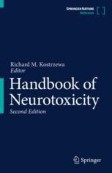Search
Search Results
-
5,6- and 5,7-Dihydroxytryptamines as Serotoninergic Neurotoxins
Dihydroxytryptamines are able to selectively destroy central serotonin neurons when catecholaminergic neurons are protected. Compared to serotonin,...
-
The Discriminative Stimulus Properties of Drugs Used to Treat Depression and Anxiety
Drug discrimination is a powerful tool for evaluating the stimulus effects of psychoactive drugs and for linking these effects to pharmacological...
-
5,6- and 5,7-Dihydroxytryptamines as Serotoninergic Neurotoxins
Dihydroxytryptamines are able to selectively destroy central serotonin neurons when catecholaminergic neurons are protected. Compared to serotonin,...
-
Species Differences in the Selective Inhibition of Monoamine Oxidase (1-methyl-2-phenylethyl)hydrazine and its Potentiation by Cyanide
The potentiating effects of cyanide on the inhibition of rat liver mitochondrial monoamine oxidase-A & B and of ox liver mitochondrial MAO-B by...

-
Scombroid Fish Poisoning
Scombroid fish poisoning, otherwise known as histamine fish poisoning (HFP), is the most common seafood poisoning in the United States related to the...
-
Exogenous gaseous superoxide potentiates the antinociceptive effect of opioid analgesic agents
The study examined the potentiation of the antinociceptive action of opioid analgesics produced by gaseous superoxide (GS) in the rat hind paw...
-
Amine precursor amino acid therapy: From neurochemical basis to clinical aspects
The particulars regarding the amine precursor therapy for treatment of neuropsychiatric disorders and their neurochemical background are described...
-
Drug Interactions and Drug-Metabolising Enzymes
Induction and inhibition of cytochrome P450 enzymes are mechanisms that underly some of the more serious drug-drug interactions; it is therefore...
-
Impairment of the Serotoninergic Innervation of the Rat Subcommissural Organ After Early Postnatal X-Irradiation of the Brain Stem
The rat subcommissural organ (SCO) is remarkable for the glandular activity of its ependymocytes, which release their secretory products in the...
-
Conditioned locomotor activity but not conditioned place preference following intra-accumbens infusions of cocaine
In the first experiment, the conditioned place preference (CPP) paradigm was used to examine the rewarding properties of bilateral microinfusions of...
-
Iproniazid
Iproniazid, the first clinically effective MAOI, was studied extensively for its psychiatric effects for a year or two following the favorable report...
-
Induction of oral stereotypy following amphetamine microinjection into a discrete subregion of the striatum
Amphetamine and other psychostimulant drugs induce perseverative motor behavior in rodents, such as compulsive sniffing, licking and biting. Although...
-
Monamine Oxidase
The enzyme monoamine oxidase (amine: oxygen oxidoreductase (deaminating) EC 1.4.3.4.) (MAO) catalyses the oxidative deamination of amines according...
-
Neurochemical and neuropharmacological properties of 4-Fluorotranylcypromine
1. The 4-fluoro analogue of the monoamine oxidase-inhibiting antidepressant tranylcypromine was compared to the parent drug with regard to the...
-
Catecholamine Receptors
Specific receptors for drugs, hormones, and neurotransmitters are found on the surface membranes of many types of cells. Interaction of a receptor...
-
Marked enhancement by clorgyline of nocturnal and daytime melatonin release in rhesus monkeys
The type A monoamine oxidase (MAO)-inhibiting antidepressant clorgyline (1 mg/kg/24 days) administered to rhesus monkeys increased night-time...
-
The negative symptoms of schizophrenia and the monoamine oxidase inhibitors
Thirty chronic ambulatory schizophrenic patients whose main psychopathology was characterized by the persistence of negative symptoms, such as...
-
Monoamine Oxidase Inhibitors: Animal Pharmacology
The animal pharmacology of the monoamine oxidase inhibitors (MAOIs*) has been reviewed previously by Zirkle and Kaiser (1964), Biel et al. (1964),...
-
Monoamine Oxidase, Monoamine-Oxidase-Inhibiting Drugs, and Human Behavior
Monoamine-oxidase- (MAO)-inhibiting drugs, which reduce the oxidative deamination of the brain biogenic amine neurotransmitters, were the first...
-
Tricyclic and Monoamine Oxidase Inhibitor Antidepressants: Structure-Activity Relationships
Tricyclic and monoamine oxidase inhibitor (MAOI) antidepressants are the two classes of drugs most frequently used in the treatment of moderate to...
